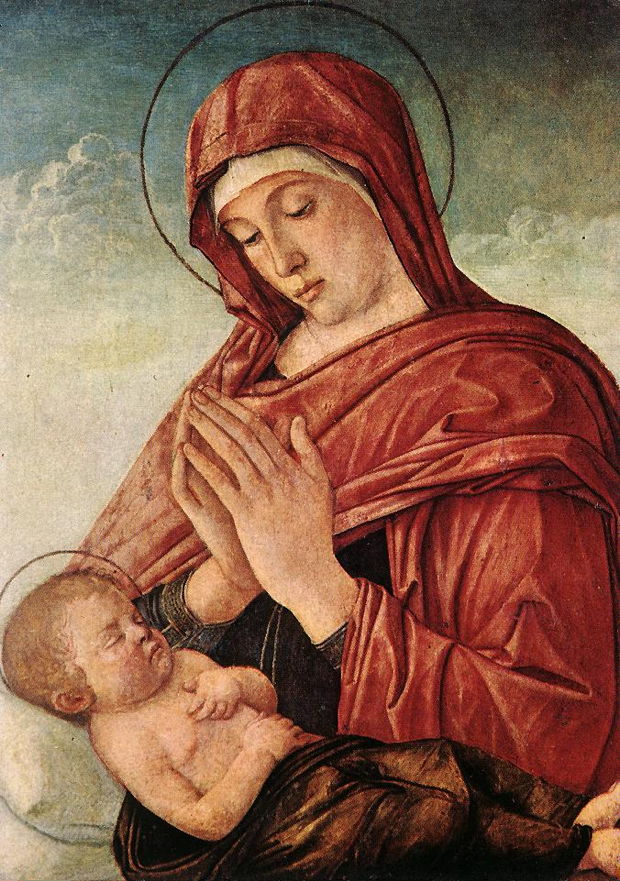“[T]he Spirit gives [new] life.”
— 2 Corinthians 3:6 & Romans 6:4
New life is always messy. And it can seem alien at first. Add to that realities like fluctuating hormones and the transition can be hard. When I was pregnant, I tried everything, including eating saltines before getting out of bed, but I still threw up in bushes a lot. I also came to know where every bathroom in town was as the new life inside me took up more room. The most mundane activities turned into unfamiliar adventures.

Madonna in Adoration of the Sleeping Child by Giovanni Bellini (c. 1475)
Surrounded by so many unknowns, a mother-to-be discovers depths of faith she didn’t know she had. In the chaos and reordering process integral to new life, vulnerable is redefined as she offers space inside herself for another.
But nothing is more vulnerable than a baby. When our ten-month-old daughter, with the help of antibiotics and Pedialyte, finally turned the corner on a high fever, she still refused food. I was struck then by how utterly dependent she was on me to coax her to eat again, one slow spoonful at a time.
At Christmas, Mary and the birth of her baby remind us that honoring and caring for vulnerability are crucial. We are to make room in us for the God of Love and New Life, for the most vulnerable of our fellow humans, and for the most fragile, hidden parts of ourselves.
In the foreword to Blessed One, Kathleen Norris says Mary is a steady reminder that “the omnipotent God chose to take on human vulnerability...of the most extreme sort” — a child born to a young woman in poverty (ix).1
Norris also contemplates Mary as a model for saying “Yes” when “the mystery of God’s love breaks through [human] denseness and doubt” (x). She celebrates Mary for becoming “God’s earthly sanctuary” and explains why God’s mother is always relevant: “Like Mary, I am invited each day to bring Christ into the world in my prayers, thoughts, and actions” (x, xi).
Light a candle then, breathe deeply, and listen to Hildegard, Mechthild of Magdeburg, and Catherine of Siena as they praise the wisdom, power, and mystery of Mary.
Hildegard honors Mary in her Book of Divine Works:
Hail to you, O greenest, most fertile branch!
You budded among breezes and winds
in search of the knowledge of everything holy.
When the time was ripe,
your own branch blossomed.
You’re marvelous! And I welcome you here.
The sun’s heat releases sweat from you
like the balsam’s perfume.
In you, the most stunning flower bloomed
and gave off its graceful fragrance.
All of the herbs and roots
dry and thirsty before your arrival
now grow in all the greens of spring.
Let us praise the Most High forever and ever!2
Hildegard also sings thanks for Mary’s participation in the mystery of salvation:
Alleluia! Mary, Light burst
from your untouched
womb like a flower
on the far side
of death. The world-tree
is blossoming. Two
realms are becoming one.
Alleluia!3
In The Flowing Light of the Godhead, Mechthild reminds us that we do well to imitate Mary’s availability to the divine mystery:
However much we are disciplined, pure, and humble in complete submissiveness — ready to serve in all holiness and rejecting all hard feelings towards others — we’re like Mary.4
Mechthild also brings us close to Mary and her child, their intimacy and their poverty:
The mother of Jesus took a coarse gray blanket from Joseph’s saddle — the one the donkey had had on his back under the saddle — and she also took the upper part of her shift under which she’d carried our Lord....Then she wrapped the hardy Savior in [them] and placed her Son gently in the crib.
Immediately, Jesus began crying like a newborn baby does. As long as babies are unable to speak, they never cry except to express a real need. That’s why baby Jesus, our Lord, wept then — despite his noble nature — because He was put to bed in a cowshed, for our base sin. Christ wept for all the world, hiding His happiness. Jesus wept for all the world, hiding His power.5
Catherine of Siena in her Dialogue reflects on Mary’s arduous, pregnant journey and its humble birthing room, a hay-and-dung-smelling stable. She asks us to hold this image in our hearts:
God said, “See baby Jesus lying between animals? And so poor,...and it was winter. So Mary kept [him] warm with the breath of animals and a blanket of hay.
“Now look again. This baby is the fire of Love, but He chose to endure the bitterest cold in His humanity. All the while My Son lived on earth, He chose to suffer.
“Consider the gentle, loving Word born in a stable while Mary was on a journey. This baby is showing you pilgrims how you should constantly be born anew in the stable of self-knowledge. There by grace you’ll find Me born within your soul.”6
May this Child of Love be born in us today. Amen.
Footnotes
1. See Blessed One: Protestant Perspectives on Mary, edited by Beverly Roberts Gaventa and Cynthia L. Rigby, 2002.
2. See Carmen Acevedo Butcher’s A Little Daily Wisdom, 2008, March 18th entry, page 60. The translations are my own.
3. See Butcher, April 1st entry, page 71.
4. See Butcher, May 18th entry, page 106.
5. See Butcher, December 24th entry, page 284.
6. See Butcher, December 23rd entry, page 284.